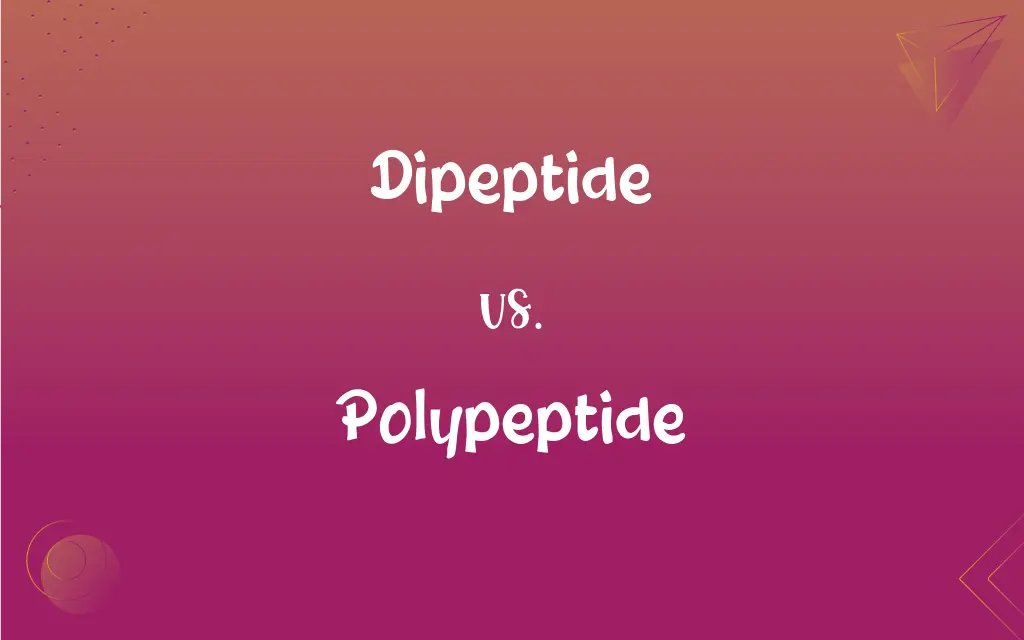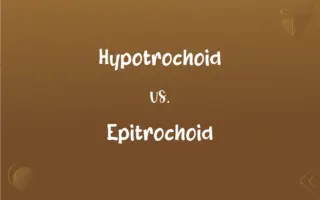Dipeptide vs. Polypeptide: What's the Difference?
Edited by Harlon Moss || By Janet White || Updated on November 29, 2023
A dipeptide is a molecule formed by two amino acids linked by a single peptide bond, while a polypeptide is a longer chain of many amino acids bonded together.

Key Differences
Dipeptides consist of two amino acids linked by a single peptide bond, representing the simplest peptides. Polypeptides, on the other hand, are longer chains comprising many amino acids, essential for forming proteins.
In terms of molecular complexity, dipeptides are relatively simple and often serve as building blocks or signaling molecules. Polypeptides are more complex, folding into specific structures to perform diverse biological functions.
Dipeptides can be quickly synthesized and broken down in the body, playing roles in metabolism and regulation. Polypeptides require more intricate synthesis processes and often undergo post-translational modifications to become functional.
In nutritional science, dipeptides can be absorbed more readily in the digestive system, offering efficient nutrient delivery. Polypeptides may need to be broken down into smaller peptides or amino acids for absorption.
Biologically, dipeptides may act as neurotransmitters or taste enhancers. In contrast, polypeptides form the structural basis of enzymes, hormones, and antibodies, crucial for various physiological processes.
ADVERTISEMENT
Comparison Chart
Number of Amino Acids
Two amino acids
Many amino acids
Molecular Complexity
Simpler structure
More complex structure
Biological Role
Building blocks, signaling molecules
Structural components of proteins
Absorption in Digestion
Rapidly absorbed
Requires breakdown into smaller units for absorption
Function in Organism
Can act as neurotransmitters, taste enhancers
Essential in enzymes, hormones, antibodies
ADVERTISEMENT
Dipeptide and Polypeptide Definitions
Dipeptide
A digestible form of two amino acids.
Certain dipeptides in food enhance flavor and nutrition.
Polypeptide
A long chain of amino acids forming part of a protein.
Insulin is a polypeptide hormone regulating blood sugar.
Dipeptide
The simplest form of peptides.
A dipeptide's structure is easier to analyze than larger peptides.
Polypeptide
Essential for cellular functions and processes.
Each polypeptide in the cell has a unique function.
Dipeptide
A molecule of two linked amino acids.
Aspartame is a dipeptide used as an artificial sweetener.
Polypeptide
Needs to be broken down for absorption.
Digestive enzymes break down polypeptides in food.
Dipeptide
Used in drug development for efficiency.
This medication contains a dipeptide for better absorption.
Polypeptide
A molecule made of many amino acids connected by peptide bonds.
Enzymes are polypeptides that catalyze biochemical reactions.
Dipeptide
Plays a role in metabolic processes.
Dipeptides can be quickly metabolized for energy.
Polypeptide
Encoded by specific gene sequences.
Genes determine the sequence of amino acids in a polypeptide.
Dipeptide
A peptide that is composed of two amino acid molecules linked by a peptide bond.
Polypeptide
A peptide, especially one composed of 10 or more amino acids.
Dipeptide
An organic compound formed from two amino acids joined by a peptide bond.
Polypeptide
(organic chemistry) Any polymer of (same or different) amino acids joined via peptide bonds.
Polypeptide
(biochemistry) Any such polymer that is not folded into a secondary structure of a protein.
Polypeptide
(protein) A small protein containing up to 100 amino acids; see also oligopeptide.
Polypeptide
A peptide containing 10 to more than 100 amino acids
FAQs
Can dipeptides be found in food?
Yes, dipeptides are present in many protein-rich foods.
Are dipeptides essential for humans?
While not essential, some dipeptides are beneficial for health and nutrition.
How are dipeptides broken down in the body?
Dipeptides are broken down by peptidases into individual amino acids.
What is the significance of dipeptides in biology?
Dipeptides play roles in nutrition, metabolism, and cellular signaling.
Do dipeptides have a specific structure?
Dipeptides consist of two amino acids connected by a peptide bond, with varying side chains.
Can dipeptides form larger peptides?
Yes, dipeptides can link with other amino acids to form longer peptides.
How are polypeptides synthesized?
They are synthesized through the process of translation in the ribosomes of a cell.
What is a common example of a dipeptide?
Carnosine, a dipeptide of beta-alanine and histidine, is a common example.
What role do polypeptides play in cells?
Polypeptides are essential for constructing enzymes, structural components, and signaling molecules in cells.
What is a dipeptide?
A dipeptide is a molecule formed by two amino acids linked by a single peptide bond.
How are dipeptides formed?
Dipeptides are formed by a dehydration synthesis reaction between two amino acids.
Are dipeptides used in supplements?
Yes, certain dipeptides are used in nutritional supplements for their health benefits.
What is a polypeptide?
A polypeptide is a long, continuous chain of amino acids linked by peptide bonds.
How do polypeptides fold into proteins?
Polypeptides fold into proteins based on interactions among their amino acids and the surrounding environment.
Can polypeptides have biological activity?
Yes, many polypeptides have significant biological activity.
Can polypeptides be used therapeutically?
Yes, certain polypeptides are used in medicine, like insulin and growth hormones.
How are polypeptides structured?
Polypeptides have a backbone of amino acid residues connected by peptide bonds, with varying side chains.
What determines a polypeptide's function?
A polypeptide's function is determined by its amino acid sequence and three-dimensional structure.
How are polypeptides different from proteins?
Proteins are polypeptides that have folded into a specific three-dimensional structure.
Are all proteins polypeptides?
Yes, all proteins are polypeptides, but not all polypeptides are functional proteins.
About Author
Written by
Janet WhiteJanet White has been an esteemed writer and blogger for Difference Wiki. Holding a Master's degree in Science and Medical Journalism from the prestigious Boston University, she has consistently demonstrated her expertise and passion for her field. When she's not immersed in her work, Janet relishes her time exercising, delving into a good book, and cherishing moments with friends and family.
Edited by
Harlon MossHarlon is a seasoned quality moderator and accomplished content writer for Difference Wiki. An alumnus of the prestigious University of California, he earned his degree in Computer Science. Leveraging his academic background, Harlon brings a meticulous and informed perspective to his work, ensuring content accuracy and excellence.































































